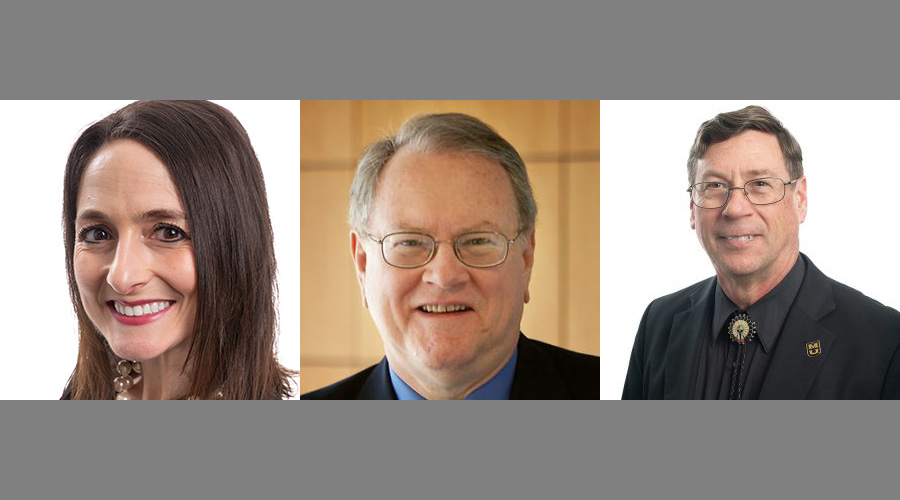
The CAFNR Ag-celerator for Agricultural Technologies (CAAT) is a translational research funding opportunity for faculty in the College of Agriculture, Food and Natural Resources (CAFNR). The CAFNR Strategic Plan established an ambitious goal to double intellectual property metrics such as invention disclosures, patents and start-up companies based on translational research done in the college. CAAT is designed to accelerate the translation of agriculture, food and natural resources innovations into products and processes that improve the lives of people in Missouri and beyond. This program bridges the gap between academic research and industry, providing funding to CAFNR faculty to bring their inventions to the marketplace. Three CAFNR faculty have been awarded the grant this year in its second round.
“We hope this funding helps take these outstanding researchers to the next level in terms of getting their technology to commercialization,” said Shibu Jose, associate dean of research in CAFNR. “We’re thrilled to be able to offer this funding for projects by Gary, Vicki and Andrew in the second round, but invite all CAFNR researchers to consider what innovations they might be able to bring to the market. It’s an exciting new era in university research, and we’re thrilled to be part of it here in our college.”
A committee consisting of representatives from the MU Office of Technology Advancement, CAFNR, industry and the investment community selected the awardees based on two rounds of competition, including a pitch talk.
Gary Stacey, Curators’ Distinguished Professor in Plant Science and Technology, was awarded $50,000 for his project, “Artificial intelligence approaches for development of novel fungicides.”
The fungicide industry as applied to agriculture has gone through little innovation over the past 50-60 years, and Stacey’s project aims to change that. Fungal diseases impact all sectors of the agricultural economy, accounting for hundreds of millions of dollars in losses each year, and for many fungal diseases there are no adequate treatments. In other cases, fungicide treatments can be expensive and can be hazardous if not properly handled to the health of farm workers, as well as the environment.
“Our project seeks to utilize AI-based approaches to design effective fungicides that are effective and of low toxicity,” Stacey said. “The latter, for example, will allow for rapid re-entry into the field after treatment, which is now severely restricted when treating with current, highly toxic fungicides. Our fungicides will be completely different from current chemical or biological products on the market.”
Stacey is initially targeting the leafy green vegetable industry. This is a complex industry with numerous players primarily based in California and Arizona that grow over 95% of the leafy greens consumed in the US. The lack of effective fungicide and resistant varieties has led to production problems due to several fungal pathogens including Pythium, Fusarium, Verticillium and Sclerotinia, for which Stacey’s team have shown efficacy with its fungicides.
Victoria (Vicki) Vieira-Potter, associate professor of nutrition and exercise physiology, was awarded $15,000 for her project, “Estrogen Receptor Beta (ERb) ligand combined with Beta-3 Adrenergic (B3A) ligand for the treatment of diabetes and pre-diabetes.”
“Obesity is a major cause of chronic disease in our society, costing upwards of $147 billion each year,” Vieira-Potter said. “Currently there are many weight loss drugs on the market but none that selectively target fat-cell metabolism. Selectively targeting fat cells would greatly minimize the side effects associated with typical weight loss drugs, making our potential therapeutic particularly impactful in terms of societal benefit.”
Her goal is to generate preclinical data to further support a US patent application. The hypothesis of Vieira-Potter’s work is that a novel combination of two compounds targeting an estrogen receptor and another fat cell-specific receptor will have synergistic benefits in improving fat-cell metabolism in obese people.
“Our lab has joined forces with a pharmacologist/drug developer from the Ohio State University who has recently formulated a novel estrogen receptor beta selective compound that we are now testing in combination with the other therapeutic,” Vieira-Potter said. “The CAAT grant funded this pilot study, which generated findings that support that our unique therapeutic combination indeed increases fat loss and activates fat-cell metabolism. These data are exciting and lend support to our US patent application.”
Andrew Clarke, associate professor of food science, was awarded $15,000 for his project, “A sustainable, rapid brewer for specialty light coffee roasts.”
Clarke’s project focuses on automating the production of light-roasted coffee for either a home use or cafe setting. Using ultrasound, researchers initiate and collapse microscopic bubbles at the surface of the coffee ground and the hot water. In doing so, they can speed up how quickly the coffee is able to brew, and effectively brew the tougher and more dense grounds that come from a light-roasted bean compared to a medium or dark roasted bean.
Clarke’s prototype machine is able to emulate the consumer acceptability of a pour-over coffee without the continuous effort of a barista or home user and can brew the same serving size in one quarter of the time. He is also currently exploring other potential partnerships and industrial applications of ultrasound-assisted production to a wider variety of beverages.
“This CAAT award allows us to conduct the automation and the acceptance testing of light-roasted coffee brewed with ultrasound required to attract potential industrial interest and allows us to expand the principles of ultrasonic-assisted beverage production into other potential products and partnerships,” Clarke said.